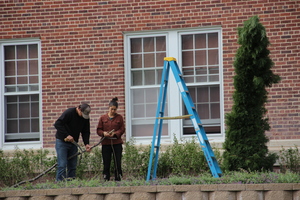Tree recovery plan underway

A multi-year plan is in place for tree recovery at Chadron State College due to damage caused by Winter Storm Atlas.
CSC horticulturist Lucinda Mays and members of the grounds crew, with the help of students and other volunteers, have completed phase one which consisted of initial cleanup of downed branches.
About 90 percent of the 1,000 trees within the managed or built landscape incurred some type of broken limbs. Very few of the 700 trees planted within the past 10 years were lost, due being young, resilient and having had proper structural pruning.
Phase two is underway now with crews releasing compromised limbs. About 50-60 trees on campus will eventually need to be replaced due to the storm effects. So far, 12 of these have been removed and replaced.
The cut-off time for the ideal fall planting season ends the weekend after Thanksgiving, according to Mays.
“We are trimming for aesthetics, strength and safety. A tree does not have structural integrity if the trunk itself is split. These are living things, not just lumber, and we take that into account when deciding which ones to remove,” Mays said.
Phase three, in March and April, will consist of pruning in collaboration with local arborists and also planting replacement trees. The ideal diameter of a branch at pruning time is one to two inches. Over four inches leaves a major wound on the tree and most tree are unable to heal over that size of opening.
The fourth phase includes observing the sprouts which emerge from pruned locations, letting them grow, selecting the most dominant and strongly attached shoots to remain and trimming off the others. This process will repeat over the next 10 years.
Mays explained that some splayed upright junipers on campus have undergone a process in which bamboo poles are inserted into the center and then twine is wrapped around the splayed sections of the tree loosely binding them to the bamboo supports. All materials used are biodegradable.
These and other trees are also being propped up by poles made of black walnut. Black walnut, one of the hardest woods, suffered the most breakage. Mays said this fact highlights the issue at the crux of the massive damage – included bark. Included bark is created due to improper pruning, and almost every break occurred at one of these places.
Included bark is created when a branch grows at less than a 90 degree angle away from the trunk or another branch. The strength of the tree is comprised because bark is then growing inside the tree instead of on the outside.
No extra fertilizer will be placed around the damaged tree and they will be watered and mulched in a normal fashion.
This winter, due to the extra stress evergreen trees experienced, they will be sprayed with pinene, a natural, waxy substance that serves as a coating to hold moisture in the tree.
Category: Campus Events, Campus News


